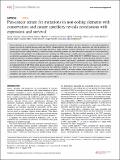Pan-cancer screen for mutations in non-coding elements with conservation and cancer specificity reveals correlations with expression and survival
Author(s)
Hornshøj, Henrik; Nielsen, Morten Muhlig; Sinnott-Armstrong, Nicholas A.; Świtnicki, Michał P.; Juul, Malene; Madsen, Tobias; Sallari, Richard; Kellis, Manolis; Ørntoft, Torben; Hobolth, Asger; Pedersen, Jakob Skou; ... Show more Show less
DownloadPublished version (2.450Mb)
Terms of use
Metadata
Show full item recordAbstract
Cancer develops by accumulation of somatic driver mutations, which impact cellular function. Mutations in non-coding regulatory regions can now be studied genome-wide and further characterized by correlation with gene expression and clinical outcome to identify driver candidates. Using a new two-stage procedure, called ncDriver, we first screened 507 ICGC whole-genomes from 10 cancer types for non-coding elements, in which mutations are both recurrent and have elevated conservation or cancer specificity. This identified 160 significant non-coding elements, including the TERT promoter, a well-known non-coding driver element, as well as elements associated with known cancer genes and regulatory genes (e.g., PAX5, TOX3, PCF11, MAPRE3). However, in some significant elements, mutations appear to stem from localized mutational processes rather than recurrent positive selection in some cases. To further characterize the driver potential of the identified elements and shortlist candidates, we identified elements where presence of mutations correlated significantly with expression levels (e.g., TERT and CDH10) and survival (e.g., CDH9 and CDH10) in an independent set of 505 TCGA whole-genome samples. In a larger pan-cancer set of 4128 TCGA exomes with expression profiling, we identified mutational correlation with expression for additional elements (e.g., near GATA3, CDC6, ZNF217, and CTCF transcription factor binding sites). Survival analysis further pointed to MIR122, a known marker of poor prognosis in liver cancer. In conclusion, the screen for significant mutation patterns coupled with correlative mutational analysis identified new individual driver candidates and suggest that some non-coding mutations recurrently affect expression and play a role in cancer development.
Date issued
2018-01Department
Massachusetts Institute of Technology. Computer Science and Artificial Intelligence LaboratoryJournal
NPJ Genomic Medicine
Publisher
Springer Science and Business Media LLC
Citation
Hornshøj, Henrik et al. "Pan-cancer screen for mutations in non-coding elements with conservation and cancer specificity reveals correlations with expression and survival." NPJ Genomic Medicine 3, 1 (January 2018): 1 © 2018 The Author(s)
Version: Final published version
ISSN
2056-7944